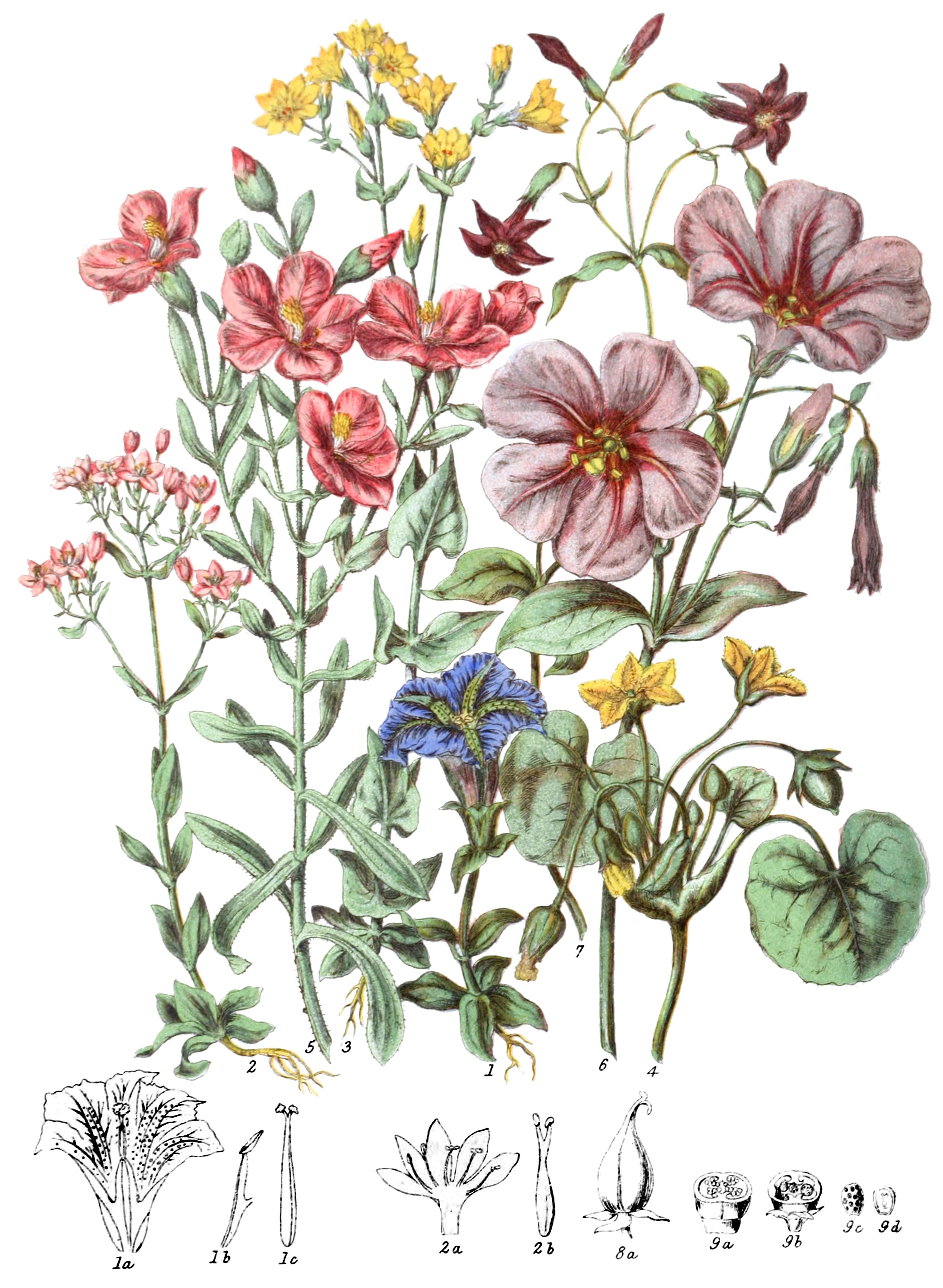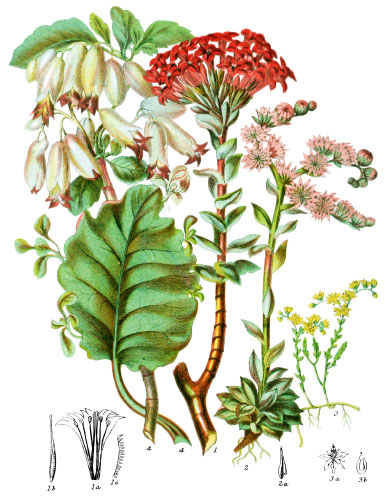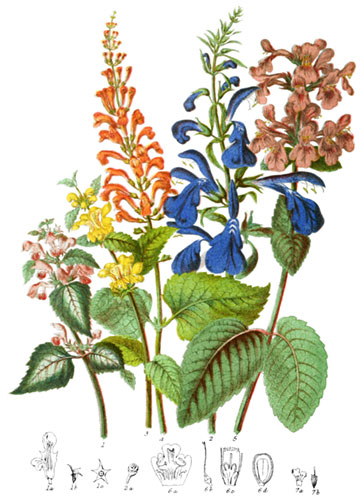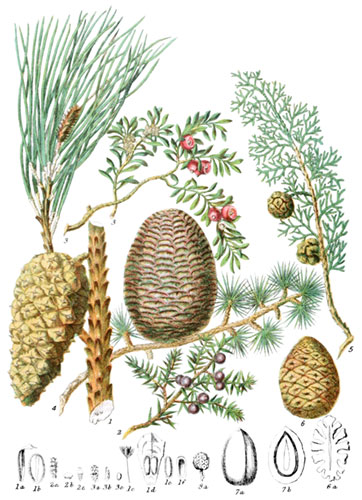Key characteristics
Herbaceous plants, and a very few shrubs; generally smooth, occasionally of a twining habit. The leavs are opposite, rarely alternate; usually without leaf-stalks, sometimes having stalks widened at the base into a kind of sheath; entire at the edges, generally three-ribbed, without stipules. The flowers are at the ends of the branches, or at the base of the leaf-stalks, regular, very seldom irregular. The calyx is below the ovary, divided at the top, persistent. The corolla is of one petal attached to the base of the ovary, tubular below, divided above into from four to eight segments, equal to those of the calyx; the top of the tube, or the segments sometimes finely fringed; the corolla is sometimes prolonged into a spur at the base; in the bud state plaited or folded. The stamens are inserted on the corolla, alternate with its segments; some are occasionally imperfect. The ovary is composed of two carpels, one or two celled, many-seeded. The style is single, stigmas two; the seed-vessel is a capsule or a berry containing many seeds on the margins of the valves. The seeds are small, and contain soft fleshy albumen.
This Tribe has close affinity with Apocynaceæ, but is without milky juice, and the seed-vessel usually a capsule, not a follicle.
Intensely bitter juice exists in these plants.
Select plants in this order
Not all plants listed are illustrated and not all plants illustrated are listed.
- Pliny relates that Gentius, King of Illyria, was the first to discover and appereciate the tonic properties of the genus, which was consequently named after him Gentiana.
- G. lutea, of the Alps, is one of the most powerfully bitter species; in some parts it covers wide tracts, but remains untouched by cattle; the root is large, affording an abundant supply of the bitter juice for medicinal purposes; formerly it was used instead of hops for beer.
- The root of G. purpurea is often two feet in length, and is sometimes substituted for that of G. lutea.
- G. acaulis (1) is a lowly species, but its single flower is large and very beautiful.
- All these plants flourish best in their native situations, but if in a suitable soil and undisturbed, the stalkless Gentian forms a pleasing ornament of the garden in spring, when flowers are rare.
- G. amarella and G. campestris grow on open heaths and fields; the top of the tube of the corolla is curiously bearded, but the colour is a dull purple, much less attractive than the usual intense blue.
- A traveller in Switzerland will often admire with surprise the noble specimens of tall blue Gentian growing on the Alpine pastures, or on the verge of glaciers. A lofty elevation is favourable to them generally.
- G. imbricata ascends to 8600 feet on the Alps; G. nivalis flourishes nearly on the limit of perpetual snow, unfoldng its brilliant blue flowers amidst the wildest rocks and mountain torrents. One species is found on the Andes at 13,800 feet; another in Ceylong between 6000 and 8000 feet above the sea. Cool and pur air is essential to this genus; it is therefore rare in hot countries, except on mountains; near the equator it is not found below 7800 feet on the Andes.
- G. viscosa, with yellow flowers, belongs to the Canaries, several others to Siberia.
- G. prostrata ahs an extensive range on the surface of the globe, inhabiting the Alps of Carinthia to the height of 9000 feet, the Altai Mountains in N. lat. 52°, the summits of the Rocky Mountains in North America at an elevation of 16,000 feet, growing on plains on the sea-level in Behring’s Straits, on the eastern slopes of the Andes in S. lat, 35°, and at the Straits of Magellan.
- G. aphylla, bearing its erect yellow flowers with few or no leaves, adorns hollow trees in the woods which clothe the hills in the island of Martinique.
- G. concinna produces its delicate flowers, striped with red and white, in Lord Auckland’s Isles in the far south.
- Erythræa (2)* is a good example of our British Flora, exhibiting in a small type a very perfect representation of a peculiar characteristic; the twisting of the anthers after having discharged the pollen as clearly shown in this delicate little flower as in the closely-allied genus Chironia (5).
- Chlora (3) is one of the remarkably neat plants that grow on the cliffs of Dover, and in a few other chalk districts; the elegant golden flowers expand during sunshine in July. The whole plant is bitter, and yields a yellow dye.
- Villarsia nymphoides (4) extends its long roots in the margins of the river Thames at Hampton and higher up; the stems are several feet in length, and are kept floating by means of the large heart-shaped leaves. A link with the water-lilies is observable in the leaves being rolled inwards when young; it is a native also of the Lake of Cashmere.
- Exacum is another British genus belonging likewise to India.
- The most valuable plant we possess in this tribe is the Bogbean Menyanthes trifoliata; the triple leaf is not to be mistaken for any other, and the exquisitely fringed flowers are exceedingly beautiful. The intensely bitter properties render it an extremely valuable remedy.
- Lisianthus was first imported from Jamaica towards the close of the last century.
- L. Russellianus (6) is of later introduction from Mexico.
- The root of Frasera affords a pure bitter tonic in North America, used like that of Gentiana.
- Agathotes chirayta is equally useful in the Himalayas.
- Voyra is an exception to the general character of these plants, having no leaves, only small brown scales, and a parasitical root.
Locations
This Tribe extends over almost every part of the world, from plains to the verge of perpetual snow; most abundant on the Alps and the Andes; less frequent in extreme north and south latitudes; rare in New Zealand, Tasmania, Greenland, Iceland, and the Arctic and Antarctic islands; unknown within the Polar regions.
Legend
- Gentiana acaulis, Dwarf Gentian. Europe.
- Flower opened.
- Stamen.
- Pistil.
- Erythræa* centaurium, Common Centaury. England.
- Flower opened.
- Ovary and Pistil.
- Chlora perfoliata, Perfoliate Yellow-wort. Chalk, England.
- Villarsia nymphoides, Fringed Buckbean. Borders of the Thames.
- Chironia decussata. Cape of Good Hope.
- Lisianthus Russellianus. Mexico.
- Leianthes nigrescens. Guatemala.
-
- Gentiana lutea. Capsule.
-
- Chironia baccifera. Section of Ovary.
- Section of Fruit.
- Seed.
- Section.
*Erithræa was spelled “Erithrea” in the description.
Explore more
Posters
Decorate your walls with colorful detailed posters based on Elizabeth Twining’s beautiful two-volume set from 1868.
Puzzles
Challenge yourself or someone else to assemble a puzzle of all 160 botanical illustrations.





